In an age where consumers are more informed and selective than ever, hard-sell tactics no longer cut it. Businesses need to cultivate trust and understand their clients’ needs to break the ice. And that’s where content marketing can be your secret weapon.
Content marketing in Tech and SaaS is a strategic compass for connecting with your target audience. It’s your foundation for crafting and distributing content designed to captivate and convert. And it’s one of the most essential tools to drive adoption.
At its core, content marketing is about engaging your audience through valuable content that emotionally resonates. And in Tech and SaaS, it’s also about bridging the gap between complex technologies and potential users. You can do that by knowing where your audience is, meeting them there, and guiding them to where they want to be.
In this article, we’ll examine the indispensable role content marketing plays in the Tech and SaaS industries and successful strategies that get results. Finally, we’ll cover the future of content marketing in Tech and SaaS and the next steps your company can take to elevate to the next level.
The Role of Content Marketing in Tech and SaaS Industries
The Tech and SaaS industries are characterized by fierce competition and continuous innovation. Standing out requires more than just an excellent product or service. It requires going above and beyond that. And in today’s world, it’s all about the client experience.
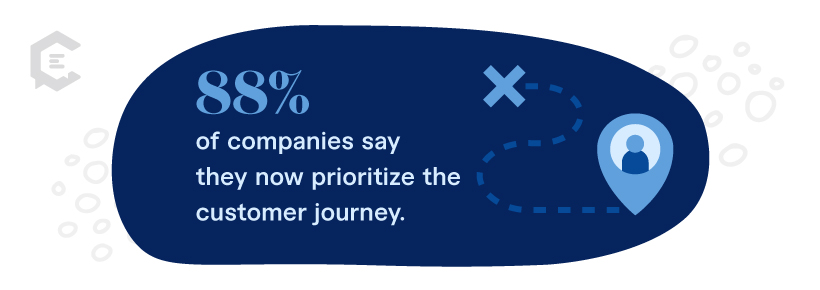
In a recent study, 88% of companies say they now prioritize the customer journey. These additional stats make it clear why:
- 66% of customers expect companies to understand their needs [Hubspot]
- Customer-centric companies are 60% more profitable than ones that aren’t [Hubspot]
- 86% of consumers would leave a brand after two poor experiences [Emplifi]
With the focus now on the customer journey, a top-level content marketing strategy is essential.
Why Content Marketing Matters
In a recent study, 86% of buyers said they would pay more for a great customer experience. And when it comes to improving that customer experience, your content creation is a driving force. Compelling content hooks your audience and forges a deep emotional connection that invests them in the experience of your company. Using interactive elements like quizzes and videos creates immersive experiences that encourage active participation.
By folding these elements together, you create an unforgettable customer experience that sets your brand apart. And the benefits don’t stop there. Content marketing can also:
- Showcase your brand’s authenticity by being honest and transparent.
- Nurture long-term customer loyalty and create brand ambassadors.
- Improve your brand recognition and profile in the digital marketplace.
- Establish your company as a thought leader that educates and guides.
Driving Innovation and Adoption Through Content
Innovation drives the Tech and SaaS industry. But with that innovation comes numerous challenges. The biggest one? Driving adoption. You could have the best tech or software in the entire industry. If your audience can’t understand what it is, they won’t buy it.
So, how do you convince potential users to adopt a new technology or switch from an existing solution to your SaaS product?
Here are a few ways that content marketing could help achieve your goals:
- Create educational content to demystify new tech or SaaS solutions.
- Break down complex concepts into digestible nuggets of information that reassure your audience. That reassurance fosters trust and builds an emotional relationship with your customers.
- Showcase real-world applications and success stories that alleviate resistance and drive product adoption.
- Explain the tangible benefits and ROI of your company’s tech or SaaS solution.
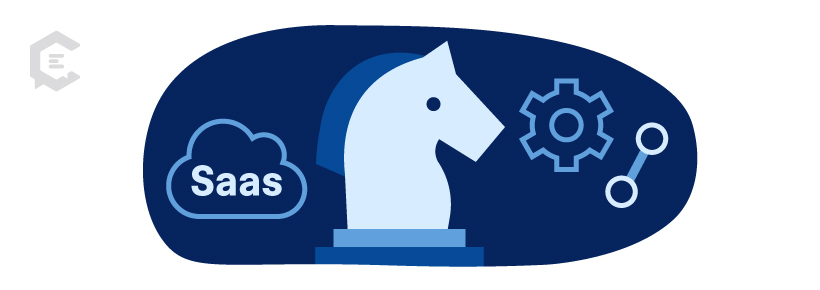
Successful Content Marketing Strategies in Tech and SaaS
Creating content is only the first step. To achieve success, you must ensure all content aligns accurately with your brand’s mission. You’ll also need to promote and distribute content so that it reaches your intended audience. From there, you’ll need to continuously review your results and make adjustments and improvements along the way.
Here are some strategies for getting the most out of your content marketing efforts:
Produce High-Quality, Engaging Content
Content marketing isn’t about producing large volumes of content. It’s about crafting content that stands out and emotionally resonates with your target audience.
Here are just a few of the benefits of high-quality content
- Search engine visibility: High-quality content leads to engagement metrics like increased time on page, higher click-through rates, and lower bounce rates. And all of these metrics signal to search engines that your website is relevant and valuable. That leads to improved search rankings and increased organic traffic, creating greater visibility and exposure for your brand.
- Higher audience engagement: High-quality content creates an emotional connection. That connection captures an audience’s attention and motivates them to engage with your brand. Before you know it, they’re deep into their buyer’s journey. That active engagement also strengthens your relationship with existing customers. And it helps you attract new ones.
At the end of the day, high-quality content establishes a strong brand presence in the digital landscape. You’re one step closer to achieving your business goals by standing out and attracting a wider audience.
Leveraging Multiple Content Formats
Today’s consumers are everywhere. Some are on websites; others are on social media or email inboxes. A multi-channel approach is critical to maximize your brand’s reach. That reach drives engagement which can, in turn, drive adoption. Companies with multi-channel engagement strategies retain 89% of their customers. And 87% of companies say multi-channel marketing is critical to their success.
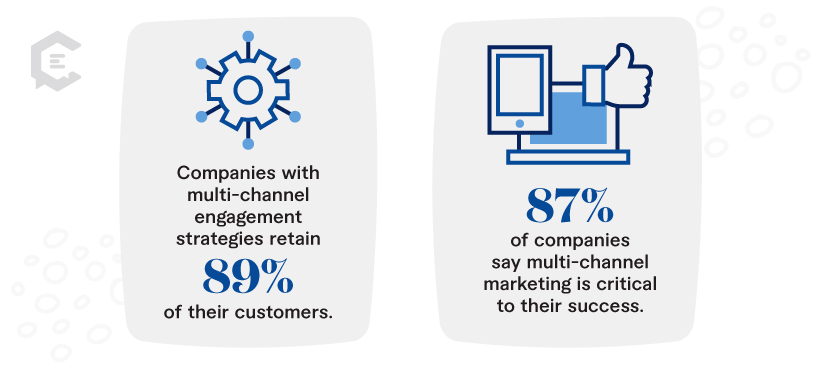
A high-quality content strategy is crucial for coordinating that multi-channel approach. It ensures you connect with your audience on numerous platforms providing multiple entry points for discovering your brand. That lets you pull them in and guide them through their customer journey. It also ensures each channel’s content works harmoniously to serve your company’s mission and goals.
Establishing Thought Leadership
Thought leadership is a fantastic way for any brand to stand out. But it’s especially powerful in the tech and SaaS sectors. Publishing authoritative, forward-thinking content builds your reputation as an innovative leader in your field. That reputation helps you shape industry conversations and influence other decision-makers. It positions you as a brand that consumers can trust and rely on most.
Some thought leadership content might include:
- Data-driven Whitepapers that analyze a new technology or software
- Newsletters with expert insights on the latest industry trends
- Blog articles that are opinion pieces on technology developments
- In-depth eBook guides that address key challenges your audience faces
Case Study Example: Nutanix
Cloud computing firm Nutanix’s online publication, The Forecast, is a great example of thought leadership in the SaaS space. They’ve made their site a central source of information on the latest industry news and trends, putting their company at the forefront of the SaaS space. The content is organized into different categories using a clean design that makes it easy for the user to navigate. And they incorporate other formats like podcasts and videos to keep their content fresh, interactive, and engaging.
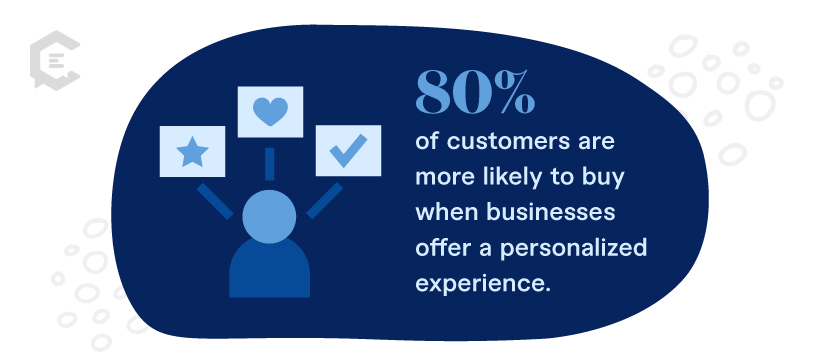
Personalizing Content for Different Audience Segments
Personalized content is a highly effective way to connect with audiences. 80% of customers are more likely to buy when businesses offer a personalized experience. And 60% say they’ll become repeat buyers after a customized experience.
Personalization enhances your audience’s experience and strengthens your relationship with them. And that relationship increases the likelihood of conversions and customer retention. But creating personalized content first means you have to understand your audience.
That means understanding:
- Who they are
- Where they are
- What they need
- What challenges their facing
- Their behaviors and interests
- Their pain points
It’s essential to have a complete understanding of your audience. Once you do, you can start crafting content that captures their attention and emotionally resonates with them. Both of which will ultimately drive conversions.
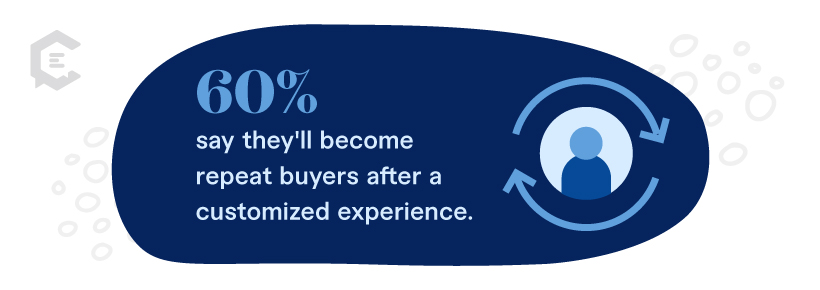
Audience Segmentation
One of the best ways to learn about your audience is through audience segmentation.
Audience segmentation divides your audience into smaller groups based on specific characteristics. Each group can then be a template for a different buyer persona that helps you hone in on whom you’re targeting.
These characteristics range from:
- Age
- Location
- Occupation
- Income
- Behavior
- Tech & SaaS knowledge
- Tech & SaaS goals
Once you have your audience segments, you can create highly personalized content for each group.
But remember, your audience is always evolving. It’s important to evolve with them. Always make sure to review and recalibrate your content strategy. Engagement metrics are a great way to do this. Those metrics give you great feedback that you can use to adjust your content as needed.
Case Study Example: Amazon
The average website visitor will leave after only 15 seconds of reading. And more than 60% will not return. That’s a lot of pressure. And that’s where the power of personalization can be a game-changer. No one does it better than Amazon. Their personalized product curation is borderline unparalleled. Almost 35% of their sales come from personalized recommendations. And nearly 56% of those are likely to turn into repeat buyers.
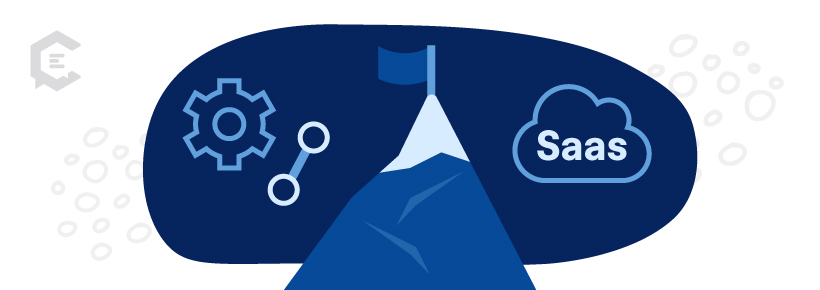
Overcoming Content Marketing Challenges in Tech and SaaS
While Tech and SaaS content marketing presents many opportunities, it also brings unique challenges. It can be easy to fall into some mistakes. Let’s look at the most common pitfalls and how to navigate them successfully.
Making Complex Concepts Accessible
Obstacle: The Tech and SaaS sectors are full of complex concepts and technological jargon. It’s easy for your audience to get overwhelmed trying to understand everything. That can freeze them on their buyer’s journey and make them less likely to convert.
Solution: Present complex concepts in a way that’s easy to understand. Break them down into digestible, engaging pieces of content. Visual aids are always a great way to do this. Animations, videos, data visualizations, and infographics are all fantastic options. That engagement will empower your audience and boost your brand recognition.
Keeping Up with Rapid Technological Changes
Obstacle: The Tech and SaaS industries are constantly evolving. New developments, trends, technologies, and innovations emerge rapidly. It can feel impossible to keep up.
Solution: Keep your content up-to-date and relevant by following a consistent posting schedule. Use data in your content operations to regularly review all metrics. Continuously research the latest industry trends and monitor your competitors for new developments. And keep your content marketing strategy flexible to swiftly adapt to changes.
Standing Out in a Crowded Market
Obstacle: The tech and SaaS market is oversaturated. Making your voice heard above the noise can be challenging.
Solution: Pinpoint your unique selling proposition (USP) and make it the centerpiece of your content marketing efforts. What makes your product or service different or better than the rest? Answering that question can help you develop a compelling brand story that separates you from the competition and helps you cut through the noise.
The best USPs follow these guidelines:
- Unique: Distinguish what you’re selling from everything else. What makes you a one-of-one?
- Selling: Convey why someone needs what you’re offering
- Proposition: The declarative statement. Don’t be tentative. Claim your authority but in a way that’s meaningful and connected to your customer.
Use the complexity and dynamism of the tech and SaaS industries as fuel for your content marketing strategy. That way, you can turn these potential pitfalls into stepping stones to success.

The Future of Content Marketing in Tech and SaaS
As technology advances at an unprecedented rate, so does content marketing in the Tech and SaaS industries. To stay competitive, it’s crucial to anticipate emerging trends and prepare for the future.
That means:
- Staying up-to-date on new technologies
- Experimenting with those new technologies
- Leveling up your team with any new skills they need
- Keeping your content strategy updated to align with evolving trends and customer behaviors
Staying at the forefront of your industry keeps your edge over the competition. With that in mind, let’s see what the future has in store for Tech and SaaS content marketing.
Embracing AI
More than 80% of industry experts already use some form of AI in their marketing. Nowhere is that felt more than in the Tech and SaaS industries. And it’s just getting started. The proper use of AI can revolutionize your content marketing strategy. It processes massive amounts of data instantaneously and is great at automating lower-level tasks. It can free you up to concentrate on higher-level work. If you want to compete in the Tech and SaaS industries, investing in AI for your company is beyond essential. You don’t want to get left behind.
Personalization
As we mentioned earlier, personalization is the name of the game. 99% of marketers say personalization helps advance customer relationships. And that will only continue. Companies will keep tailoring content to individual customer preferences and needs. The future of Tech and SaaS content marketing lies in delivering hyper-personalized experiences that resonate with customers on a profound level. That means leveraging data is more important than ever as well. Having a strong analytics department is essential to get the metrics you need to design your personalized content.
Video Dominance
Visual content will continue dominating content marketing, especially in Tech and SaaS. 91% of companies use video as a marketing tool.
Here are some other stats to think about:
- 85% of marketers credit video as an effective way to get attention
- 80% of consumers prefer video over written text
- Customers retain 95% of the information contained in a video
Video is also one of the best ways to combine information with emotional storytelling. Plus, there’s the exciting emergence of VR and AR. Both create immersive experiences that can leave a lasting impact on your audience.
Preparing for the Future in Tech and SaaS
Preparing for the future of content marketing in Tech and SaaS means being adaptable and forward-thinking. It means investing in new technologies, upskilling your team, and continuously adjusting your strategy based on data insights and industry trends. Leveraging all of these tactics requires a strong content marketing strategy foundation.
And regarding that foundation, we’re here to help you.
At ClearVoice, our managed content creation team can offer comprehensive Tech and SaaS content marketing solutions tailored specifically to your brand’s needs.
Talk to us today to learn how we can skyrocket your Tech and SaaS content marketing strategy to the next level.



